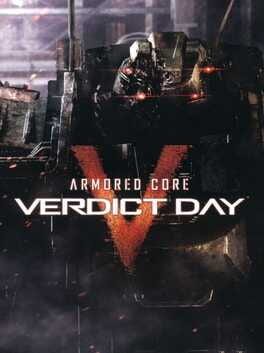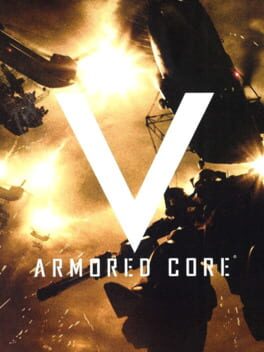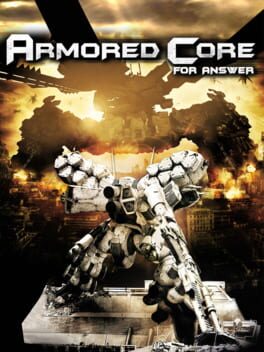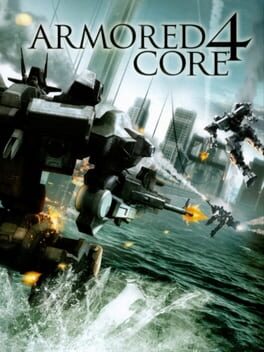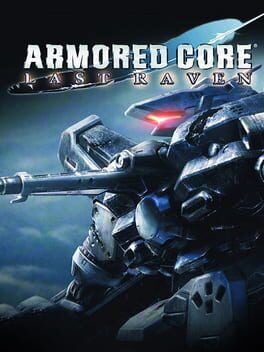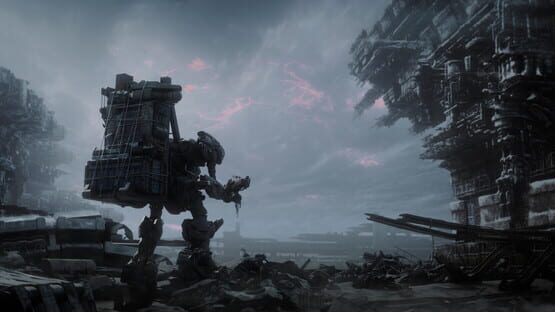

Armored Core VI: Fires of Rubicon
released on Aug 24, 2023
By combining FromSoftware’s longstanding expertise in mech games and their signature robust gameplay, Armored Core VI: Fires of Rubicon will be a new action experience.
Also in series
Released on
Genres
Reviews View More
This review contains spoilers
Armored Core is defined by an industrial coldness, and such inhumanity is central to the dramatic questions of its newest entry. There isn't a single human being to be seen in the entire game, their presence indicated only by voice over and the hulking mechs they inhabit. Rubicon itself is a planet dotted with colossal megastructures and sprawling metropolises with a bevy of institutions and organizations fighting for control of them as well as the hybrid power source and data conduit substance known as Coral that enticed them there. There’s the derelict scientific institute that established the initial research into the substance and caused the cosmic disaster that hangs over the planet, the governing authority that administers over the remaining Coral reserves, the two corporate powers occupying the planet in order to extract wealth from its veins, and the beleaguered locals struggling to liberate their home. (Editors note: there are actually even more factions in this game!) However, regardless of the faction in question, there’s nary a whiff of culture to be seen, beyond corporate logos and military decals. It’s a vision of humanity's future set on a planet of war where all of our efforts as a people have gone solely into creating the most fucked up mechs, the most overwhelming missile barrages, and the most devastating laser volleys possible. It is within this bleakness that From Software asks the player to answer the question of whether humanity can be trusted to evolve past its current form. It makes for the most interesting moral choice in From Soft’s modern catalog, however not all elements of the game support it as well as it could have.
In order to bring themselves into such a position where they can make such a call, players build and customize their mechs from an arsenal of parts and fight for the highest bidder. There are dozens of stats on display affecting your mech's performances, and figuring out how to balance the tradeoffs of each component to build a cohesive machine is half the fun. This customization is one of the more successful thematic aspects of Armored Core VI, being the vessel in which players express themselves and form an identity. Aside from their name (separate from their callsign, Raven), no aspect of the player character is customizable, or even viewable. Raven is, in essence, their mech, and as such, constantly in flux.
The combat that this customization is in service of is balletic and bombastic, with hefty assault charges and nimble boost dodges, and has a engaging learning curve as the player gradually comes accustomed to managing the considerable mental stack regarding the range and ammunition of four different weapons at once, alongside the mech’s own engine and cooldown capacities. As is typical of From Soft games, spikes in difficulty are often just as much knowledge checks as they are tests of skill and dexterity, and those who love tinkering will be ecstatic over the range of options to try out when they encounter a progress barrier. However, the balancing of the game is too lopsided in order to fully facilitate this intended approach; the stagger system, disconnected from the parries of Sekiro that defined it in that game, heavily rewards burst damage, and if you have powerful ammunition on hand when an enemy is staggered, even Armored Core VI’s fiercest enemies will swiftly crumble. For the most part, my first playthrough was based around upgrading and tinkering with parts for a central mech design I created early on, and the design I took into the final battle shredded every threat it faced in NG+ and NG+2 (on patch 1.02). This undermined the structure that New Game+ is meant to facilitate in this game, which is utilizing the repetition of replaying the game’s various missions as an opportunity to try out new mech designs, and unfortunately I found that NG+2 disappointing in the story department as well.
The story in Armored Core VI the first two routes are quite compelling. It has far more dialogue than any of From Soft’s Soulslikes, including Sekiro, which helps to bring personality to the sheer complexity and density of its proper nouns and headier ideas. There are occasional blemishes, of course. Front of mind is Handler Walter’s dramatically inert off-screen ‘death’, which is, confusingly, only vaguely alluded to. Then there’s the matter of Gen IV augmentation, one of a plethora of established experiments in modifying physiology in order to better pilot Armored Core mechs, which leaves it unclear what Raven’s psychological capabilities are in regards to free will, which muddies the messaging around player choice and the will to choose. However, most of the twists and turns land impactfully, and the decisions to be made are hefty enough that either route of the base story shines through as a memorable and meaningful experience. NG+2, titled ‘Alea lacta Est’ has a lot going for it by focusing around the mercenary support group ALLMIND and their hidden agenda of implementing the Human Instrumentality Project from Neon Genesis Evangelion. It may not be original, but it’s a good thematic fit for the game. This is undermined however by the fact that Alea lacta Est replaces the dramatic gravitas found in the finales of prior playthroughs, with what is essentially a joke. Low rank mercenary G5 Igauza’s petty resentment of the player character takes center stage over a hypothetical antagonist that could have more directly and cleanly represented opposition to the player character’s goals. Sure, G5 Igauza as a foil is meant to represent how one could squander the will to choose, but it doesn’t register when Armored Core VI’s depiction of humanity is already so consumed with war and profit. It doesn't help that the game’s final image is a straight up goofy way of expressing its status quo shift, becoming an instance where the game’s commitment to never showing human faces goes a bit too far, and hardly feeling like a worthy reward to the considerable grind required to reach the ending. It adds up to one of those cases where the masterpiece version of a game is so clearly visible in its released form, but it falls short in a few key places, even if it doesn't stop it from being great overall.
In order to bring themselves into such a position where they can make such a call, players build and customize their mechs from an arsenal of parts and fight for the highest bidder. There are dozens of stats on display affecting your mech's performances, and figuring out how to balance the tradeoffs of each component to build a cohesive machine is half the fun. This customization is one of the more successful thematic aspects of Armored Core VI, being the vessel in which players express themselves and form an identity. Aside from their name (separate from their callsign, Raven), no aspect of the player character is customizable, or even viewable. Raven is, in essence, their mech, and as such, constantly in flux.
The combat that this customization is in service of is balletic and bombastic, with hefty assault charges and nimble boost dodges, and has a engaging learning curve as the player gradually comes accustomed to managing the considerable mental stack regarding the range and ammunition of four different weapons at once, alongside the mech’s own engine and cooldown capacities. As is typical of From Soft games, spikes in difficulty are often just as much knowledge checks as they are tests of skill and dexterity, and those who love tinkering will be ecstatic over the range of options to try out when they encounter a progress barrier. However, the balancing of the game is too lopsided in order to fully facilitate this intended approach; the stagger system, disconnected from the parries of Sekiro that defined it in that game, heavily rewards burst damage, and if you have powerful ammunition on hand when an enemy is staggered, even Armored Core VI’s fiercest enemies will swiftly crumble. For the most part, my first playthrough was based around upgrading and tinkering with parts for a central mech design I created early on, and the design I took into the final battle shredded every threat it faced in NG+ and NG+2 (on patch 1.02). This undermined the structure that New Game+ is meant to facilitate in this game, which is utilizing the repetition of replaying the game’s various missions as an opportunity to try out new mech designs, and unfortunately I found that NG+2 disappointing in the story department as well.
The story in Armored Core VI the first two routes are quite compelling. It has far more dialogue than any of From Soft’s Soulslikes, including Sekiro, which helps to bring personality to the sheer complexity and density of its proper nouns and headier ideas. There are occasional blemishes, of course. Front of mind is Handler Walter’s dramatically inert off-screen ‘death’, which is, confusingly, only vaguely alluded to. Then there’s the matter of Gen IV augmentation, one of a plethora of established experiments in modifying physiology in order to better pilot Armored Core mechs, which leaves it unclear what Raven’s psychological capabilities are in regards to free will, which muddies the messaging around player choice and the will to choose. However, most of the twists and turns land impactfully, and the decisions to be made are hefty enough that either route of the base story shines through as a memorable and meaningful experience. NG+2, titled ‘Alea lacta Est’ has a lot going for it by focusing around the mercenary support group ALLMIND and their hidden agenda of implementing the Human Instrumentality Project from Neon Genesis Evangelion. It may not be original, but it’s a good thematic fit for the game. This is undermined however by the fact that Alea lacta Est replaces the dramatic gravitas found in the finales of prior playthroughs, with what is essentially a joke. Low rank mercenary G5 Igauza’s petty resentment of the player character takes center stage over a hypothetical antagonist that could have more directly and cleanly represented opposition to the player character’s goals. Sure, G5 Igauza as a foil is meant to represent how one could squander the will to choose, but it doesn’t register when Armored Core VI’s depiction of humanity is already so consumed with war and profit. It doesn't help that the game’s final image is a straight up goofy way of expressing its status quo shift, becoming an instance where the game’s commitment to never showing human faces goes a bit too far, and hardly feeling like a worthy reward to the considerable grind required to reach the ending. It adds up to one of those cases where the masterpiece version of a game is so clearly visible in its released form, but it falls short in a few key places, even if it doesn't stop it from being great overall.
I'm now a long-time fan of From Software's work, but a newcomer to the Armored Core series. Nonetheless, when I finally saw the 6th installment being announced after just as many years of rumors as Bloodborne's remasters, I could not wait to jump into it. Knowing that I am not generally a fan of any big mechs media and especially videogames - besides Evangelion - I still embarked on it regardless solely because of From Software's pedigree.
Not an old engine, just slow adoption.
Armored Core VI, just like Sekiro and Elden Ring runs on the in-house engine of From Software, not Pyre as many still think to this date. An engine that wasn't failing the test of time yet, unlike Bethesda's Creation Engine; with Elden Ring, though, debates and doubts did spark. The biggest offender was the forced lock at 60fps on an engine modders have been unlocking days after release, consistently. This is a hindrance only to the longevity and futureproofing of the title, especially when hardware becomes more powerful and inevitably newer heavier games become lighter and more performant.
At the time, the promise and consequent addition of ray tracing to the game had kindled hope in me that it was not a problem with the engine at all, but Armored Core took those cinders and made them burn, removing that doubt completely.
The game has 120fps lock and ray-tracing - the latter just in the garage - at lunch.
Sadly, the anti-aliasing remains not necessarily the strongest option on the market and I strongly hope soon they'll start implementing FSR and DLAA in their titles, but, it's not unserviceable.
The options I was perplexed about and removed immediately were the Depth of Field and Motion Blur combo, which added this weird blurry effect at the edges of the camera and on distant objects. Still, it is possible to turn it off, so no complaints there.
Graphically the game is stunning, performance are great, solid, and stable which is what such a fast-paced game needs.
I was happy to finally see a photo mode that could make the inner photographer in me rejoice in being able to take stunning, planned, HUD-less screenshots in these games, and that made me even more hopeful that with Shadow of the Erdtree we might also hopefully - please, please, please - get it in Elden Ring alongside the 120fps lock option!
Raven's wings of freedom.
The game's story follows your character, 621, call name Raven. You're a fourth-generation augmented human - of which currently there are ten generations in total to my understanding - capable of controlling the giant mechs known as Armored Core.
The augmentation is performed using Coral; think of it as a very flammable fuel capable of reproducing itself that can apparently be used as a drug, gas, and it can also control wave properties, digital and electronic equipment, etc. but deadly during extended contact with humans.
Coral is very important to the various corporations who fight for it, but at the same time need to control it to avoid a rendition of the Fires of Ibis. The Fires of Ibis was a previous cataclysm where the coral, again, very flammable, took fire starting from Rubicon 3 and killed countless people and burned away the majority of life in this solar system, as well as destroying technology and infrastructure, wiping out all of the system's civilization. A fire so hot it would burn the very stars.
Back to 621, we work under Handler Walker, who'll guide us through the basics and provide us with missions for us to complete as a freelancer.
Honestly, the mobility of the mech, the inertia, the weight of your actions, and the amazing scale of the world around you are enough of a reason for you to purchase this game alone because they did a wonderful job!
Missions are not too long, often being just the right length around 20-30m, if not shorter, besides some selected story missions. Each mission will then have a payment reward, from which costs are reduced, and with the rewarded credits, you can buy more parts to change your mech up.
It's possible to pause the game at any time, and on death, there's the option to restart from checkpoints that are automatically made during missions. It is even possible to change which parts your mech has equipped - but not buy new ones - without ever leaving the mission and losing your progress.
The game, like Nier: Automata, features multiple endings achievable through multiple playthroughs and different choices in New Game +, which - another big shocker - does not increase difficulty. So playing the game over and over is a playground for you to use more and more stuff and builds to face your threats.
This is on top of mission replayability to get better scores in them, secret caches with new parts around the maps, enemies hidden with logs, lore documents, etc. There is a lot to do!
When it comes to Arenas, there are PVP rooms available where you can fight other players - up to 6v6 I think - and there is also an offline virtual ranked Arena where you can fight ACs of other pilots you meet in the game, which will unlock some more weapons, and customization options. Speaking of which.
Exploration is customization.
One thing that I did wrong in this game was entering with the idea exploration was key, or so I thought. Exploration is key, but whereas in a Souls/RPG you'll be exploring your surroundings, the world, and what you find in it, here, you need to explore different builds, from the get-go. This took me so out of my element, especially with the steep learning curve, that I am thankful I had purchased the game and made a commitment to it because it gave me the strive to keep hitting my head against the wall until making new builds and trying new approaches became the default. It brought back memories of my early days playing Dark Souls 1, teaching me to focus on the lessons learned from challenges rather than dwelling on setbacks. Each failed try against a boss here it's just another opportunity to learn it better or try something else.
While later mech and weapons parts might be stronger, the game overall is very balanced around making every option viable to the player and any option performs just as well. Difficulty, while the game might become more complex going forward, won't stop you from using the shotgun you bought at the start of the game. Other options you'll be given will be different, instead of better. You can't improve these parts and for everything they offer more than the one you currently use, it takes away somewhere else.
Customization doesn't stop at being able to change parts or simply color them but goes in depth from sheene, to wear, to being able to make your own custom decals and such. I've seen people making YouTube tutorials on how to make a paint job feel more realistic, i.e. adding small white dots on bolts, or wear lines of the primary color on top of accent lines to add to the wear the fact that the top layer has pealed off but not the main paint job. With more than 40 slots available for customization for each mech part, this is seriously the Disney Land of mech fanatics. This is the level of attention to detail I put into Skyrim through modding, but it's a default. Amazing!
Last but not least, builds including looks can be shared with everyone, who, with a build code and the right parts can import it with a few clicks!
Conclusion.
Overall, although it's not my next Elden Ring, I enjoyed my time on the title sometimes making me wish I would have been playing this on some evenings over Baldur's Gate 3. It was fun, like with Sekiro, to see another facet of From Software, and familiar mechanic concepts applied in new innovative ways and I think I will be looking out for what's next for this series, hopefully in less than 10 years!
7.9/10
Not an old engine, just slow adoption.
Armored Core VI, just like Sekiro and Elden Ring runs on the in-house engine of From Software, not Pyre as many still think to this date. An engine that wasn't failing the test of time yet, unlike Bethesda's Creation Engine; with Elden Ring, though, debates and doubts did spark. The biggest offender was the forced lock at 60fps on an engine modders have been unlocking days after release, consistently. This is a hindrance only to the longevity and futureproofing of the title, especially when hardware becomes more powerful and inevitably newer heavier games become lighter and more performant.
At the time, the promise and consequent addition of ray tracing to the game had kindled hope in me that it was not a problem with the engine at all, but Armored Core took those cinders and made them burn, removing that doubt completely.
The game has 120fps lock and ray-tracing - the latter just in the garage - at lunch.
Sadly, the anti-aliasing remains not necessarily the strongest option on the market and I strongly hope soon they'll start implementing FSR and DLAA in their titles, but, it's not unserviceable.
The options I was perplexed about and removed immediately were the Depth of Field and Motion Blur combo, which added this weird blurry effect at the edges of the camera and on distant objects. Still, it is possible to turn it off, so no complaints there.
Graphically the game is stunning, performance are great, solid, and stable which is what such a fast-paced game needs.
I was happy to finally see a photo mode that could make the inner photographer in me rejoice in being able to take stunning, planned, HUD-less screenshots in these games, and that made me even more hopeful that with Shadow of the Erdtree we might also hopefully - please, please, please - get it in Elden Ring alongside the 120fps lock option!
Raven's wings of freedom.
The game's story follows your character, 621, call name Raven. You're a fourth-generation augmented human - of which currently there are ten generations in total to my understanding - capable of controlling the giant mechs known as Armored Core.
The augmentation is performed using Coral; think of it as a very flammable fuel capable of reproducing itself that can apparently be used as a drug, gas, and it can also control wave properties, digital and electronic equipment, etc. but deadly during extended contact with humans.
Coral is very important to the various corporations who fight for it, but at the same time need to control it to avoid a rendition of the Fires of Ibis. The Fires of Ibis was a previous cataclysm where the coral, again, very flammable, took fire starting from Rubicon 3 and killed countless people and burned away the majority of life in this solar system, as well as destroying technology and infrastructure, wiping out all of the system's civilization. A fire so hot it would burn the very stars.
Back to 621, we work under Handler Walker, who'll guide us through the basics and provide us with missions for us to complete as a freelancer.
Honestly, the mobility of the mech, the inertia, the weight of your actions, and the amazing scale of the world around you are enough of a reason for you to purchase this game alone because they did a wonderful job!
Missions are not too long, often being just the right length around 20-30m, if not shorter, besides some selected story missions. Each mission will then have a payment reward, from which costs are reduced, and with the rewarded credits, you can buy more parts to change your mech up.
It's possible to pause the game at any time, and on death, there's the option to restart from checkpoints that are automatically made during missions. It is even possible to change which parts your mech has equipped - but not buy new ones - without ever leaving the mission and losing your progress.
The game, like Nier: Automata, features multiple endings achievable through multiple playthroughs and different choices in New Game +, which - another big shocker - does not increase difficulty. So playing the game over and over is a playground for you to use more and more stuff and builds to face your threats.
This is on top of mission replayability to get better scores in them, secret caches with new parts around the maps, enemies hidden with logs, lore documents, etc. There is a lot to do!
When it comes to Arenas, there are PVP rooms available where you can fight other players - up to 6v6 I think - and there is also an offline virtual ranked Arena where you can fight ACs of other pilots you meet in the game, which will unlock some more weapons, and customization options. Speaking of which.
Exploration is customization.
One thing that I did wrong in this game was entering with the idea exploration was key, or so I thought. Exploration is key, but whereas in a Souls/RPG you'll be exploring your surroundings, the world, and what you find in it, here, you need to explore different builds, from the get-go. This took me so out of my element, especially with the steep learning curve, that I am thankful I had purchased the game and made a commitment to it because it gave me the strive to keep hitting my head against the wall until making new builds and trying new approaches became the default. It brought back memories of my early days playing Dark Souls 1, teaching me to focus on the lessons learned from challenges rather than dwelling on setbacks. Each failed try against a boss here it's just another opportunity to learn it better or try something else.
While later mech and weapons parts might be stronger, the game overall is very balanced around making every option viable to the player and any option performs just as well. Difficulty, while the game might become more complex going forward, won't stop you from using the shotgun you bought at the start of the game. Other options you'll be given will be different, instead of better. You can't improve these parts and for everything they offer more than the one you currently use, it takes away somewhere else.
Customization doesn't stop at being able to change parts or simply color them but goes in depth from sheene, to wear, to being able to make your own custom decals and such. I've seen people making YouTube tutorials on how to make a paint job feel more realistic, i.e. adding small white dots on bolts, or wear lines of the primary color on top of accent lines to add to the wear the fact that the top layer has pealed off but not the main paint job. With more than 40 slots available for customization for each mech part, this is seriously the Disney Land of mech fanatics. This is the level of attention to detail I put into Skyrim through modding, but it's a default. Amazing!
Last but not least, builds including looks can be shared with everyone, who, with a build code and the right parts can import it with a few clicks!
Conclusion.
Overall, although it's not my next Elden Ring, I enjoyed my time on the title sometimes making me wish I would have been playing this on some evenings over Baldur's Gate 3. It was fun, like with Sekiro, to see another facet of From Software, and familiar mechanic concepts applied in new innovative ways and I think I will be looking out for what's next for this series, hopefully in less than 10 years!
7.9/10

